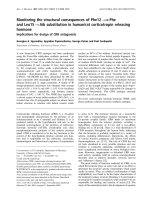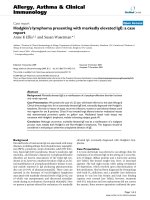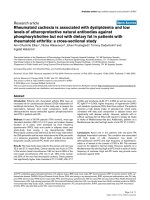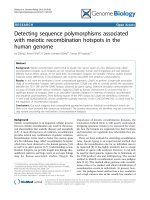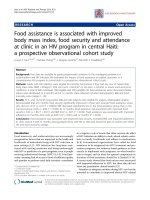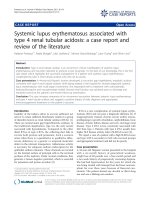Báo cáo y học: "Primary effusion lymphoma associated with Human Herpes Virus-8 and Epstein Barr virus in an HIV-infected woman from Kampala, Uganda: a case repor" pptx
Bạn đang xem bản rút gọn của tài liệu. Xem và tải ngay bản đầy đủ của tài liệu tại đây (847.31 KB, 5 trang )
CASE REP O R T Open Access
Primary effusion lymphoma associated with
Human Herpes Virus-8 and Epstein Barr virus in
an HIV-infected woman from Kampala, Uganda:
a case report
Lynnette K Tumwine
1*
, Rejani Lalitha
2
, Claudio Agostinelli
3
, Simon Luzige
2
, Jackson Orem
4
, Pier Paolo Piccaluga
3
,
Lawrence O Osuwat
1
, Stefano A Pileri
3
Abstract
Introduction: Primary effusion lymphoma is a recently recognized entity of AIDS related non-Hodgkin lymphomas.
Despite Africa being greatly affected by the HIV/AIDS pandemic, an extensive MEDLINE/PubMed search failed to
find any report of primary effusion lymphoma in sub-Saharan Africa. To our knowledge this is the first report of
primary effusion lymphoma in sub-Saharan Africa. We report the clinical, cytomorphologic and
immunohistochemical findings of a patient with primary effusion lymphoma.
Case presentation: A 70-year-old newly diagnosed HIV-positive Ugandan African woman presented with a three-
month history of cough, fever, weight loss and drenching night sweats. Three weeks prior to admission she
developed right sided chest pain and difficulty in breathing. On examination she had bilateral pleural effusions.
Haematoxylin and eosin stain ed cytologic sections of the formalin-fixed paraffin-embedded cell block made from
the pleural fluid were processed in the Department of Pathology, Makerere University, College of Health Sciences,
Kampala, Uganda. Immunohistochemistry was done at the Institute of Haematology and Oncology “L and A
Seragnoli”, Bologna University School of Medicine, Bologna, Italy, using alkaline phosphatase anti-alkaline
phosphatase method. In situ hybridization was used for detect ion of Epstein-Barr virus.
The tumor cells were CD45+, CD30+, CD38+, HHV-8 LANA-1+; but were negative for CD3-, CD20-, CD19-, and
CD79a- and EBV RNA+ on in situ hybridization. CD138 and Ki-67 were not evaluable. Our patient tested HIV
positive and her CD4 cell count was 127/μL.
Conclusions: A definitive diagnosis of primary effusion lymphoma rests on fi nding a proliferation of large
immunoblastic, plasmacytoid and anaplastic cells; HHV-8 in the tumor cells, an immunophenotype that is CD45
+, pan B-cell marker negative and lymphocyte activated marker positi ve. It is essential for clinicians and
pathologists to have a high index of suspicion of primary effusion lymphoma when handling HIV positive
patients who have effusions without palpable tumor masses. Basic immunohistochemistry is essential for
definitive diagnosis.
* Correspondence:
1
Department of Pathology, School of Biomedical Sciences, Makerere
University College of Health Sciences, Mulago Hill Road, PO Box 7072,
Kampala, Uganda
Full list of author information is available at the end of the article
Tumwine et al. Journal of Medical Case Reports 2011, 5:60
/>JOURNAL OF MEDICAL
CASE REPORTS
© 2011 Tumwine et al; licensee BioMed Central Ltd. This is an Open Access a rticle distributed under the terms of the Creative
Commons Attribution License ( which permits unrestricted use, distribution, and
reproduction in any medium, provided the original work is properly cited.
Introduction
Primaryeffusionlymphoma(PEL)isarareaggressive
B-cell lymphoma which was first identified in 1989 as a
subset of body-cavity-based lymphomas [1,2]. It
accounts for only 0.13% of all AIDS related malignancies
among AIDS patients in the USA [3]. The WHO classi-
fication recognizes it as a unique entity of non-Hodgkin
lymphoma (NHL) [2].
It has been suggested that Kaposi sarcoma herpes
viru s/Human herpes virus-8 (KSHV/HHV-8) is the cau-
sative agent of PEL. In Europe and America very high
seroprevalences of HHV-8 (around 67%) have been
reported among HIV-positive men who have sex with
men [4]. It was initially thought that the transmission in
Western countries was sexual [5], however, a recent
study in Texas showed high HHV-8 seroprevalences of
26% among children, indicating another mode of trans-
mission of HHV-8 [6].
In Africa, studies have shown considerable variation in
the seroprevalence rates of HHV-8 infection among
adults and children; the highest adult rates of 26-100%
have been found in Uganda, Cameroon, Ivory Coast,
Gambia, the Democratic Republic of Congo, Tanzania,
Zambia and South Africa.
Nigeria, Ghana, Zimbabwe and Egypt have prevalence
rates of 50% and the countries with relatively low rates
of 25% and below are the Central African Republic, Eri-
trea and Senegal [7].
A recent study revealed increasing seroprevalence of
HHV-8 with age among Ugandan children, from 10%
among two-year-olds to 36.4% in eight-year-olds, in
contrast to South African children where there were ser-
oprevalence rates of 7.5-9% [8].
In East and Central Africa, the HHV-8 seroprevalence
reaches 80% in the adult population. In Uganda, HHV-8
seroprevalence is approximately 40% in adulthood and
studies have also confirmed transmission by blood
transfusion [9,10].
In sub-Saharan Africa, there have been very few reports
of PEL and this is probably because effusions are often
not made into cell blocks, and even when they are, no
immunohistochemistry is performed [11,12]. Hence, it is
possible that PEL is being missed as an important sub-
type of AIDS-related NHL [13]. Despite HIV, Epstein-
Barr virus (EBV) and HHV-8 being endemic in Uganda,
no case of PEL has, before now, been reported from the
country. We report a case of PEL in a 70-year-old HIV-
infected woman from Kampala, Uganda.
Case presentation
A 70-year-old newly diagnosed HIV-positive Ugandan
African woman presented with a three-month history of
cough, fever, weight loss and drenching n ight sweats.
Three weeks prior to admission she developed right
sided chest pain and d ifficulty in breathing. There was
no histo ry of haemoptysis or bleeding from any site. She
had occasion al palpitations. There was no history of leg
swelling, orthopnea or paroxysmal nocturnal dyspnoea.
She had been vomiting for two days prior to admission,
but had no oral sores or alteration in bowel habits.
A review of the rest of her systems was unremarkable.
This was her first admission to hospital; she reported
having been unwell for three months and had received
treatment for cough from a nearby clinic. As she was
newly diagnosed with HIV, she had not yet received cotri-
moxazole or highly active antiretroviral therapy (HAART).
She was nulliparous, had never married but had had sev-
eral sexual partners. She had been smoking a pipe (with
tobacco); however, she denied alcohol consumption.
On examination, she was elderly, sick looking, with
severe pallor, dehydration and wasting. She had no lym-
phadenopathy, jaundice, or edema. Her liver, spleen and
kidneys w ere not palpable. She had no Kaposi sarcoma
lesions on her skin or mucus membranes. She had
tachycardia (92 beats per minute) with a pparently nor-
mal heart sounds but she had a functional systolic mur-
mur. Her blood pressure was 125/90 mmHg. She had
tachypnoea (35 breaths per minute), reduced air entry
and fine crackles on the right side of her chest.
Results of laboratory investigations are shown in
table 1. A chest x-ray showed bilateral pleural effusions
and subcutaneous emphysema. Echocardiography
showed a mild pericardial effusion.
On ultrasonography, her liver, spleen, kidney and pan-
creas were normal in size, shape and echo pattern. Her
urinary bladder wall was normal . There was no ascites
or lymphadenopathy. Bilateral large pleural effusions
were confirmed. No solid tumor masses were present.
Table 1 Results of laboratory investigations
Laboratory test Result Normal range
Serum creatinine 172 μmol/L 44-106 μmol/L
Alanine aminotransferase 8.8 I Units/L 0-41 I Units/L
Serum calcium 2.0 mmol/L 2.2-2.6 mmol/L
Potassium 6.3 mmol/L 3.5-5.5 mmol/L
Sodium 151.2 mmol/L 135-150 mmol/L
WBC (total) 8.5 × 10
3
/μL 4-11 × 10
3
/μL
Neutrophils 62.5% 45-70%
Lymphocytes 22.0% 20-40%
Monocytes 14.4% 3-10%
Platelets 219 × 10
3
/μL 150-400 × 10
3
/μL
Haemoglobin 6.8 g/Dl 12-18 g/dL
CD4 cell count 127/μL 410-1590/μL
CD8 cell count 1178/μL 190-1140/μL
Tumwine et al. Journal of Medical Case Reports 2011, 5:60
/>Page 2 of 5
A sample of about 150 ml of pleural fluid was taken
from her right hemithorax and sent to the Department
of Pathology, Makerere University, College of Health
Sciences, Kampala, Uganda, where it was cytocentri-
fuged. The sediment was made into a cell block and
haematoxylin and eosin stained slides revealed a neo-
plastic proliferation of large lymphoid cells with round
to irregular nuclei, prominent nucleoli, and varying
amounts of vacuolated cytoplasm. There were immuno-
blastic, plasmablastic and anaplastic variants with
bizarre, pleomorphic nuclei (Figure 1A). They included
multinucleated and Reed-Sternberg-like cells. From
these findings a preliminary diagnosis of PEL was made.
Since immunohistochemistry is not routinely available
in Uganda, it was carried out at the Institute of Haema-
tology and Oncology “L and A Seragnoli” , Bologna
University S chool of Medicine, Bologna, Italy. The alka-
line phosphatase anti-alkaline phosphatase method and
the primary antibodies l isted in table 2 were used. In
situ hybridization was also used for detection of EBV.
The tumor cells were C D45+ (Figure 1C), CD30+,
CD38+, HHV-8 LANA-1+ (Figure 1D); but were nega-
tive for CD3-, CD20- (Figure 1B), CD19-, and CD79a-
and EBV RNA+ (Figure 1C inset) on in situ hybridiza-
tion. CD138 and Ki-67 w ere not eva luable. These find-
ings confirmed the diagnosis of PEL. The patient tested
HIV-positive and her CD4 cell count was 127/μL.
Treatment: She was initially rehydrated with normal
saline and 5% dextrose, and later received a blood trans-
fusion. She also received allopurinol, ceftriaxone and
metronidazole. After she had stabilized, she was given
the first course of chemo therapy with a CHOP protocol
(cyclophosphamide 750 mg/m
2
, A driamycin (doxorubi-
cin) 50 mg/m
2
and O ncovin (vincristine) 14 mg/m
2
on
day one and prednisolone 100 mg on days one to five,
repeated every 21 days). In addition, she received ome-
prazole, metoclopramide and dexamethasone. She regis-
tered some improvement after the first course of
chemotherapy and was allowed home. She was dis-
charged through the Infectious Disease Institute clinic
to be initiated on HAART. She was due to return for
subsequent anti-cancer treatment but died two days
after discharge from our hospital.
Discussion
We have reported the case of a patient who presented
with all the features of PEL that have been described
elsewhere [14,15]. This was the first AIDS defining ill-
ness in this patient even though she had very low CD4
counts.
The strong positivity for HHV-8 in this patient is
similar to what other authors have found in studies on
HIV-positive PEL patients [14,16]. HHV-8, by defini-
tion, has to be present in the tumor cells in order to
make a diagnosis of PEL [15]. The co-infection of
HHV-8 and EBV in this patient is interesting. Both
HHV-8 and EBV are g-herpes viruses and are closely
related. While evidence of HHV-8 is essential for diag-
nosis of PEL, the role of HHV-8 in the pathogenesis is
not clear. However, we know that EBV immortalizes
B-cells while HHV-8 seems not to. It would, therefore,
appear that HHV-8 by itself is not sufficient for the
development of PEL. It seems that EBV causes
unchecked proliferation of B-cells leading to develop-
ment of PEL and, according to Fan and others, “ once
PELs have developed HHV-8 appears to be the driving
force [14].” Recently, several ca ses of EBV negative
PEL have been reported implying that HHV-8 plays a
critical role in pathogenesis [17].
About 31 cases of HHV-8 independent PEL (HHV-8-
unrelated PEL-like lymphoma) have been reported in
Figure 1 At light microscopy, the sample consisted of a frankly
neoplastic population provided with plasmablastic and/or
anaplastic morphology (Figure 1A), which turned out CD3-,
CD20- (Figure 1B), CD79a-, CD45+ (Figure 1C), CD38+, CD30+,
IRF4+, LANA-1+ (Figure 1D), EBER+ (Figure 1C inset), and Ki-
67>90%. Based on these findings, we made a diagnosis of PEL.
Table 2 Primary antibodies used for diagnosis
Antibody Clone Source Antigen retrieval Dilution
CD45 LCA Dako EDTA 750 W 1:100
CD3 SP7 Immunotech EDTA 750 W 1:250
CD20 L26 Dako EDTA 750 W 1:200
CD30 Ber- H2 Prof. B Falini* EDTA 900 W 1:3
CD38 SPC32 Novocastra EDTA 750 W 1:10
CD79a JCB117 Prof. D Mason
§
EDTA 750 W 1:10
HHV8 13B10 Menarini EDTA 750 W 1:10
CD138 - Neomarkers EDTA 900 W 1:20
Ki-67 Mib-1 Dako EDTA 900 W 1:20
*Kindly provided by Prof. Brunangelo Falini, Perugia University, Perugia, Italy.
§
Kindly provided by Prof. David Y Mason, Oxford University, Oxford, UK.
Tumwine et al. Journal of Medical Case Reports 2011, 5:60
/>Page 3 of 5
the literature [18]. This new entity is now referred to
more precisely as HHV-8-unrelated large B-cell lympho-
mas because of the differences observed in its pathogen-
esis, m orphology and immunophenotype (it expresses a
B-cell phenotype u nlike PEL), and i s associated with
hepatitis C virus infection in 30-40% of cases [19]. The
clinical behavior and prognosis are significantly different
from that of PEL patients. The HHV-8-unrelated large
B-celllymphomapatientstendtohavemoreindolent
disease that has been observed to resolve spontaneously
and, when treated, these patients have a much better
prognosis than the HIV-positive, HHV-8 positive PEL
patients - who have a very poor outcome [19]. This
therefore proves that the two are separate entities.
PEL, possibly uniquely, presents as serous effusions in
the pleural, peritoneal and pericardial cavity without
identifiable tumor masses or lymphadenopathy.
The morphological presentation is as a large B-cell
neoplasm and the tumor cells contain KSHV/HHV-8
DNA and lack c-myc translocations. PEL most com-
monlyaffectsmaleAIDSpatientsandwasfirstrecog-
nized in men who have sex with men [20,21]. However,
a few cases have been reported in women. It is easily
distinguished from other lymphomas because of its unu-
sual morphology with large immunoblastic, plasmacy-
toid and/or anaplastic cells.
The immunophenotypical presentation of PEL cells is
typically as a “null” lymphocyte phenotype, meaning
that CD45 is expressed, but routine B-cell (including
surface and cytoplasmic immunoglo bulin, CD19, CD20,
CD79a) and T-cell (CD3, CD4, CD8) markers are
absent. Instead, various markers of lymphocyte activa-
tion (CD30, CD38, CD71, human leukocyte antigen DR)
and p lasma cell differentiation (CD138) are usually dis-
played [22].
PELs are of B-cell origin because they have clonal
immunoglobulin gene rearrangements [17,23].
Although immunohistochemical services are not routi-
nely available in Uganda and other resource constrained
countries, it is still possible to suspect PEL with avail-
able clinical and cytomorphologic criteria. These include
lymphomatous effusions limited to the body cavities
with no solid tumor or lymphadenopathy and pleo-
morphic large cells with immunoblastic, plasmacytoid
and anaplastic variants [20].
Regarding PEL, no optimal treatmen t has yet been
identified [24]. Most HIV-positive PEL patients receive
anthracycline-based multiagent chemotherapy (CHOP;
cyclophos phamide, doxorubicin, vincristine, and predni-
sone) and antiretroviral therapy. Patients with HHV-8
negative large B-cell lymphomas have been shown to
benefitfromimmunotherapywith rituximab since they
display B-cell immunophenotype, pleurodesis and thora-
cocentesis [25]. However, in resource poor settings such
as Uganda only CHOP and antiretroviral agents are
used [18]. NF-kappa B plays a significant role in PEL
oncogenesis. Studies using new drug regimens directed
against NF-kappa B have shown positive results. These
drugs are currently being developed for therapeutic use
[26,27].
Conclusions
Since a definitive diagnosis of PEL rests on the presence
of HHV-8 in the tumor cells, a lymphoproliferation of
large immunoblastic, plasmacytoid and/or anaplastic
cells, a n immunophenotype of leucocyte common anti-
gen CD45 positive, pan B-cell marker negative, and lym-
phocyte activated marker (CD 138, CD30, CD38, human
leukocyte antigen DR and CD71) positive, it is essential
for clinicians and pathol ogists to develop a high index
of suspicion of PEL when handling HIV-positive patients
with effusions without palpable tumor masses. Basic
immunohistochemistry to confirm the diagnosis is
necessary.
Abbreviations
CD: Cluster of differentiation; CHOP: anthracycline-based multiagent
chemotherapy (cyclophosphamide, doxorubicin, vincristine, and prednisone);
EBER: Epstein-Barr virus encoded RNA; EBV: Epstein-Barr virus; HAART: high ly
active antiretroviral therapy; HIV: human immunodeficiency virus; HHV-8:
human herpesvirus 8; KSHV: Kaposi sarcoma herpes virus; LANA-1:
Lymphoma associated nuclear antigen-1; NHL: non-Hodgkin lymphoma; PEL:
primary effusion lymphoma; WBC: white blood cell count; WHO: World
Health Organization.
Acknowledgements
Supported by a grant from BologAIL and Gruppo Delta (Bologna, Italy) for
the scientific and technological development of the Department of
Pathology of Makerere University.
Author details
1
Department of Pathology, School of Biomedical Sciences, Makerere
University College of Health Sciences, Mulago Hill Road, PO Box 7072,
Kampala, Uganda.
2
Department of Medicine, School of Medicine, Makerere
University College of Health Sciences, Mulago Hill Road, PO Box 7072,
Kampala, Uganda.
3
Unit of Hematopathology, Department of Haematology
and Oncological Sciences “L and A Seràgnoli”, S Orsola- Malpighi Hospital,
University of Bologna, Bologna, Italy.
4
Uganda Cancer Institute, PO Box 3935,
Kampala, Uganda.
Authors’ contributions
LKT conceived the idea, made preliminary diagnosis of PEL, and wrote the
manuscript. CA carried out immunohistochemistry and in situ hybridization.
RL, SL, and JO admitted and treated the patient, contributed patient data
and revised the manuscript. LOO did cytotechnology and revised the
manuscript. PPP and SAP reviewed and revised the manuscript. All authors
read and approved the final version of the manuscript.
Consent
Written informed consent was obtained from the patient’s next-of-kin for
publication of this case report and any accompanying images. A copy of the
written consent is available for review by the Editor-in-Chief of this journal.
Competing interests
The authors declare that they have no competing interests.
Received: 12 February 2010 Accepted: 14 February 2011
Published: 14 February 2011
Tumwine et al. Journal of Medical Case Reports 2011, 5:60
/>Page 4 of 5
References
1. Carbone A, Gloghini A: KSHV/HHV8-associated lymphomas. Br J Haematol
2008, 140(1):13-24.
2. Jaffe ES, Harris NL, Stein H, Vardiman JW, (Eds): World Health Organization
Classification of tumors. Pathology and Genetics of tumors of haematopoietic
and lymphoid tissues Lyon, France: IARC Press; 2001.
3. Mounier N, Spina M, Gabarre J, Raphael M, Rizzardini G, Golfier JB, Vaccher E,
Carbone A, Coiffier B, Chichino G, Bosly A, Tirelli U, Gisselbrecht C: AIDS-
related non-Hodgkin lymphoma: final analysis of 485 patients treated
with risk-adapted intensive chemotherapy. Blood 2006, 107(10):3832-3840.
4. Guanira J, Guanira JV, Casper C, Lama JR, Morrow R, Montano SM,
Caballero P, Suárez L, Whittington WL, Wald A, Sanchez J, Celum C,
Peruvian HIV Sentinel Surveillance Working Group: Prevalence and
correlates of human herpesvirus 8 infection among Peruvian men who
have sex with men. J Acquir Immune Defic Syndr 2008, 49(5):557-562.
5. Ablashi D, Chatlynne L, Cooper H, Thomas D, Yadav M, Norhanom AW,
Chandana AK, Churdboonchart V, Kulpradist SA, Patnaik M, Liegmann K,
Masood R, Reitz M, Cleghorn F, Manns A, Levine PH, Rabkin C, Biggar R,
Jensen F, Gill P, Jack N, Edwards J, Whitman J, Boshoff C: Seroprevalence
of human herpesvirus-8 (HHV-8) in countries of Southeast Asia
compared to the USA, the Caribbean and Africa. Br J Cancer 1999,
81(5):893-897.
6. Baillargeon J, Leach CT, Deng JH, Gao SJ, Jenson HB: High prevalence of
human herpesvirus 8 (HHV-8) infection in south Texas children. J Med
Virol 2002, 67(4):542-548.
7. Sarmati L: HHV-8 infection in African children. Herpes 2004, 11(2):50-53.
8. Butler LM, Dorsey G, Hladik W, Rosenthal PJ, Brander C, Neilands TB,
Mbisa G, Whitby D, Kiepiela P, Mosam A, Mzolo S, Dollard SC, Martin JN:
Kaposi sarcoma-associated herpesvirus (KSHV) seroprevalence in
population-based samples of African children: evidence for at least 2
patterns of KSHV transmission. J Infect Dis 2009, 200(3):430-438.
9. Dollard SC, Butler LM, Jones AM, Mermin JH, Chidzonga M, Chipato T,
Shiboski CH, Brander C, Mosam A, Kiepiela P, Hladik W, Martin JN:
Substantial regional differences in human herpesvirus 8 seroprevalence
in sub-saharan Africa: Insights on the origin of the “KS Belt”. Int J Cancer
2010, 127(10):2395-2401.
10. Hladik W, Dollard SC, Mermin J, Fowlkes AL, Downing R, Amin MM,
Banage F, Nzaro E, Kataaha P, Dondero TJ, Pellett PE, Lackritz EM:
Transmission of human herpesvirus 8 by blood transfusion. N Eng J Med
2006, 355(13):1331-1338.
11. Cool C, Bitter M: The malignant lymphomas of Kenya; morphology,
immunophenotype, and frequency of Epstein-Barr virus in 73 cases.
Hum Pathol 1997, 28(9):1026-1033.
12. Lazzi S, Bellan C, Amato T, Palummo N, Cardone C, D’Amuri A, De Luca F,
Beyanga M, Facchetti F, Tosi P, Leoncini L: Kaposi’s sarcoma-associated
herpesvirus/human herpesvirus 8 infection in reactive lymphoid tissues:
a model for KSHV/HHV-8-related lymphomas? Hum Pathol 2006,
37(1):23-31.
13. Mwanda O, Remick S, Whalen C: Adult Burkitt’s lymphoma in patients
with and without human immunodeficiency virus infection in Kenya. Int
J Cancer
2001, 92(5):687-691.
14. Fan W, Bubman D, Chadman A, Harrington WJ Jr, Cesarman E, Knowles DM:
Distinct subsets of primary effusion lymphoma can be identified based
on their cellular gene expression profile and viral association. J Virol
2005, 79(2):1244-51.
15. Mbulaiteye SM, Biggar RJ, Bakaki PM, Pfeiffer RM, Whitby D, Owor AM,
Katongole-Mbidde E, Goedert JJ, Ndugwa CM, Engels EA: Human herpes
virus 8 infection and transfusion history in children with sickle cell
disease in Uganda. J Natl Cancer Inst 2003, 95(17):1330-1335.
16. Carbone A, Gloghini A: HHV-8-associated lymphoma: State of the art
review. Acta Haematol 2007, 117(3):129-131.
17. Karcher D, Alkan S: Human herpes virus 8 associated body-cavity based
lymphomas in human immunodeficiency virus infected patients: a
unique B cell neoplasm. Hum Pathol 1997, 28(7):801-808.
18. Adiguzel C, Bozkurt SU, Kaygusuz I, Uzay A, Tecimer T, Bayik M: Human
herpes virus 8-unrelated primary effusion lymphoma-like lymphoma:
report of a rare case and review of the literature. APMIS 2009,
117(3):222-229.
19. Carbone A, Gloghini A: PEL and HHV8-unrelated effusion lymphomas:
classification and diagnosis. Cancer Cytopath 2008, 114(4):225-227.
20. Mbulaiteye SM, Biggar RJ, Goedert JJ, Engels EA: Pleural and peritoneal
lymphoma among people with AIDS in the United States. J Acquir
Immune Defic Syndr 2002, 29(4):418-421.
21. Cesarman E, Chang Y, Moore PS, Said JW, Knowles DM: Kaposi’s sarcoma-
associated herpesvirus DNA sequences in AIDS body cavity based
lymphomas. N Eng J Med 1995, 332(18):1186-1191.
22. Schultz T: KSHV/HHV8-associated lymphoproliferations in the AIDS
setting. Euro J Cancer 2001, 37(10):1217-1226.
23. Nador RG, Cesarman E, Chadburn A, Dawson DB, Ansari MQ, Sald J,
Knowles DM: Primary effusion lymphoma: a distinct clinicopathologic
entity associated with Kaposi’s sarcoma-associated herpesvirus. Blood
1996, 88(2):645-656.
24. Yiakoumis X, Pangalis GA, Kyrtsonis MC, Vassilakopoulos TP, Kontopidou FN,
Kalpadakis C, Korkolopoulou P, Levidou G, Androulaki A, Siakantaris MP,
Sachanas S, Andreopoulos A: Primary effusion lymphoma in two HIV-
negative patients successfully treated with pleurodesis as first-line
therapy. Anticancer Res 2010, 30(1):271-276.
25. Mantina H, Wiggill TM, Carmona S, Perner Y, Stevens WS: Characterization
of Lymphomas in a high prevalence HIV setting. J Acquir Immune Defic
Syndr 2010, 53(5):656-660.
26. Dabaghmanesh N, Matsubara A, Miyake A, Nakano K, Ishida T, Katano H,
Horie R, Umezawa K, Watanabe T: Transient inhibition of NF-kappaB by
DHMEQ induces cell death of primary effusion lymphoma without HHV-
8 reactivation. Cancer Sci 2009, 100(4):737-746.
27. Takahashi-Makise N, Suzu S, Hiyoshi M, Ohsugi T, Katano H, Umezawa K,
Okada S: Biscoclaurine alkaloid cepharanthine inhibits the growth of
primary effusion lymphoma in vitro and in vivo and induces apoptosis
via suppression of the NF-kappaB pathway. Int J Cancer 2009,
125(6):1464-1472.
doi:10.1186/1752-1947-5-60
Cite this article as: Tumwine et al.: Primary effusion lymphoma
associated with Human Herpes Virus-8 and Epstein Barr virus in an HIV-
infected woman from Kampala, Uganda: a case report. Journal of
Medical Case Reports 2011 5:60.
Submit your next manuscript to BioMed Central
and take full advantage of:
• Convenient online submission
• Thorough peer review
• No space constraints or color figure charges
• Immediate publication on acceptance
• Inclusion in PubMed, CAS, Scopus and Google Scholar
• Research which is freely available for redistribution
Submit your manuscript at
www.biomedcentral.com/submit
Tumwine et al. Journal of Medical Case Reports 2011, 5:60
/>Page 5 of 5
